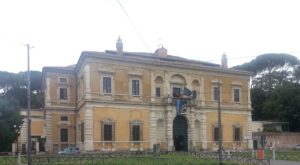
Villa Giulia
A couple of weeks ago, we took goddaughter Kitty Furse to see the Castellani exhibition at the Museo Nazionale Estrusco. As a sixth former, she’s nearing the end of her school career and fancies some gap year time designing jewelry, so was eager to see the use the Castellani family made of Etruscan jewelry in their designs.
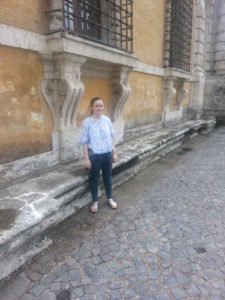
Kitty Furse and ‘kneeling’ window bracket
We’d been to the museum before, although for reasons unknown, I’d never appreciated the design of the Villa Giulia itself, the Vignola designed renaissance palace built for Pope Julius III in the middle of the 16th century, and the home of the Etruscan museum for the past century. For myself, I’d always been in primary thrall of, of course, the remains of Roman antiquity with which the local built environment is hugely supplied, and very closely followed by a love of the Roman baroque of the counter reformation of the late 16th and 17th centuries.
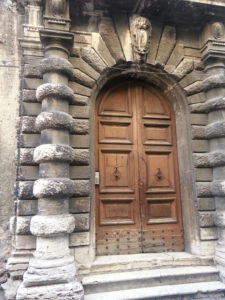
Portico of Palazzo Piccolomini Bandini, Tivoli
I suppose the inventive, if slightly overblown, architecture of Bernini and Borromini, and my enjoyment of Bernini’s hagiographic biography written by Baldinucci, tended to occlude the comparative subtlety of Renaissance classicism. Perhaps I’ve spent too much time at St Peter’s, both without and within. Mind you, I remain a fan of the Roman baroque and stoutly maintain that, while the sale of papal indulgences might arguably have had limited effect to ameliorate time in purgatory, the resultant huge influx of lucre into Catholic Rome left a real feast for the eyes for the living.
At the Villa Giulia, I was immediately struck by Vignola’s use of rustication to define the entrance portico. The banded columns while not a motif unique to Vignola, nevertheless seemed a favorite, as he repeated this often, including, as I noticed a day or two later, the portico of the Palazzo Piccolomini Bandini in Tivoli. The why of this, however, is a mystery, and certainly bears further study.
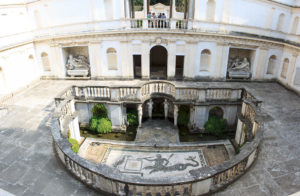
Vasari’s nymphaeum
However, Vignola’s work parallels that of his near contemporary Serlio, and it was Serlio who authored a codification of Roman classicism, using Vitruvius as his point of departure. While it might be that Vignola fancied banded columns to connote rustication, I don’t think I am extending too far out on a limb to opine that this was much a studied and significant motif. In the two uses I’ve cited, the buildings had a close connection with the papacy, so doubtless the anthropomorphism Vitruvius and then Renaissance architects and scholars liked to attribute to the classical orders doubtless considered this as spare and sober, right and proper for princes of the church.
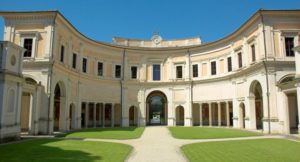
Villa Giulia interior colonnade- serenity in intercolumniation
With the fairly unadorned façade, it is a surprise to see the wealth of architecture within, including a rather elaborate nymphaeum, the design attributed to Vasari. However, it is looking back from the nypmphaeum to the arched colonnade that, in my opinion, provides the most impressive arrangement. Composed of a pleasing mixture of ionic columns- the shafts themselves reused from antiquity- at ground level, centred in the middle and anchored at either end with the what might be taken as triumphal arches, the composition is at once impressive, and yet not at all forbidding.
